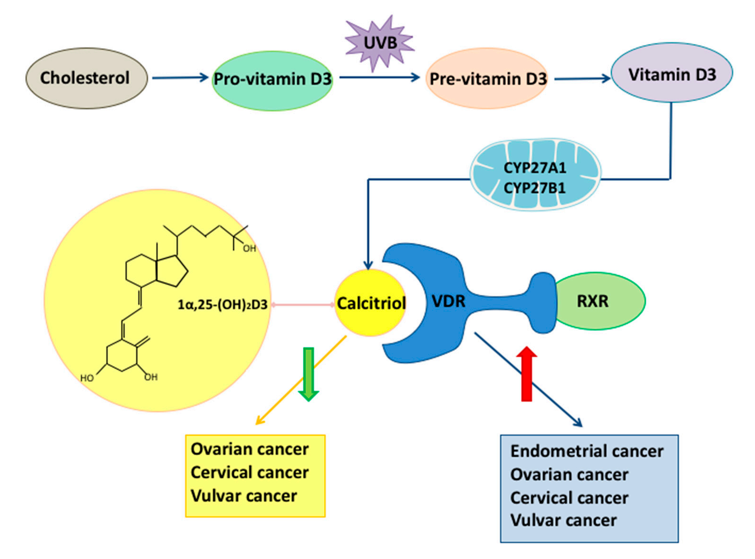
Our promise to you:
Guaranteed product quality, expert customer support.
 24x7 CUSTOMER SERVICE
24x7 CUSTOMER SERVICE
 CONTACT US TO ORDER
CONTACT US TO ORDER
VDR Gene Editing 
Vitamin D is converted to the dihydroxylated derivative, 1,25-dihydroxyvitamin D3 [1,25(OH)2D3] by successive hydroxylations in the kidney and liver. The active form of vitamin D plays an important role in regulating both mucosal immunity and normal growth of epithelial cells. Vitamin D receptor (VDR), as a member of the nuclear receptor superfamily, mediates the biological activity of 1,25(OH)2D3. The vitamin D-VDR endocrine system has been identified in almost all nucleated cells. VDR can regulate a variety of illnesses in intestine, heart, bone, kidney, skin, and various other organs. For example, the specific deletion of VDR in the mammary epithelium significantly inhibits pubertal mammary gland development.
VDR and Human Intestinal Inflammation
Functionally, VDR and 1,25(OH)2D3 are considered to be key players in calcium homeostasis and in electrolyte and blood pressure regulation. Recent evidence suggests that vitamin D deficiency is a key factor in the pathology of inflammatory bowel disease (IBD) and other diseases. Vitamin D and VDR seem to be important immunological regulators of the microbial community. Aberrant immune responses and dysbiosis (imbalanced bacteria profile) are associated with various diseases. Intestinal inflammation is mainly caused by the activation of nuclear factor-kappa B (NF-ĸB). VDR is known to downregulate NF-ĸB signaling and ameliorate intestinal inflammation by its interaction with NF-ĸB and its inhibitor inhibitory kappa B kinase beta (IKKβ). Interaction of VDR with NF-ĸB p65 blocks nuclear translocation to reduce inflammatory response. Loss of VDR in intestinal epithelial cells and MEF cells results in increased NF-ĸB signaling, which promotes pro-inflammatory cytokine production. In macrophage cells, vitamin D activation of VDR promotes interaction of VDR with the NF-ĸB p50 subunit, which prevents LPS-induced proliferation by blocking colocalization of NF-ĸB p50 with KLF5. Similarly, vitamin D treatment can prevent lipopolysaccharide (LPS)-induced placental inflammation through promoting dimerization of VDR with NF-ĸB p65. Therefore, suppression of NF-ĸB signaling by VDR ameliorates inflammation, which supports the use of vitamin D supplementation in inflammatory diseases, such as IBD.
VDR and Gynecological Cancers
A large number of in vivo and in vitro studies have proved the importance of VDR as an inflammatory mediator, insulin-like growth factor signaling and estrogen-related pathways. In addition, the VDR is expressed in a significant number of tumor tissues, suggesting that the receptor influences cancer etiology. VDR polymorphisms have been shown to change the activity of the vitamin D-VDR complex. The most common polymorphisms associated with tumorigenesis are Apa1, Bsm1, Fok1, Taq1. The interaction of VDR with the retinoid X receptor (RXR) means that also the RXR may have a modulating effect on gynecological cancers. A recent study supports this thesis, suggesting that the Retinoid X receptor and the VDR are overexpressed in BRCA1 mutated breast cancer cases, predicting the overall survival. RXR was highly expressed in ovarian cancer cells. Moreover, it has been shown that RXR polymorphisms play a role in the development of certain cancers. An interaction between RXR and VDR polymorphisms was confirmed, indicating their effects on the risk of ovarian cancer.
 Figure 1. The role of vitamin D and VDR in gynecological cancers. (Deuster E, et al., 2017)
Figure 1. The role of vitamin D and VDR in gynecological cancers. (Deuster E, et al., 2017)
VDR Gene Editing Services
CRISPR/Cas9 PlatformCB, one of the leading biotechnological companies specializing in gene editing, is dedicated to offering comprehensive CRISPR/Cas9 gene-editing services to a wide range of genomics researchers. Based on our platform, we can help you effectively VDR gene deleted, inserted or point mutated in cells or animals by CRISPR/Cas9 technology.
- VDR Gene Knockout: We offer VDR gene knockout cell line and knockout animal model generation service with high quality. Typically, we develop CRISPR-mediated gene editing cell lines including HEK239T, Hela, HepG2, U87, but we can use other cell lines according to your requirements. Our one-stop KO animal model generation service covers from sgRNA design and construction, pronuclear microinjection to Founders genotyping and breeding.
- VDR Gene Knockin: CRISPR/Cas9 PlatformCB provides the one-stop VDR knock-in cell line and knockout animal model generation services, including point mutation and gene insertion. Our expert staff has succeeded in dozens of VDR knock-in cell line generation projects, including stem cells, tumor cells and even difficult-to-handle cells. We also have extensive experience in incorporating CRISPR/Cas9 technology into animal models, which have been fully recognized by our clients.
If you have any questions, please feel free to contact us.
Related Products at CRISPR/Cas9 PlatformCB
| CATALOG NO. | PRODUCT NAME | PRODUCT TYPE | INQUIRY |
| CCKM0514 | B6J-Vdrem1Cd | Knockout Mouse | Inquiry |
| CDKM-0301 | B6J-Vdrem1Cflox | Knockout Mouse | Inquiry |
| CLKO-1668 | VDR KO Cell Lysate-HeLa | Knockout Cell Lysate | Inquiry |
| CSC-RT1819 | VDR Knockout Cell Line-HeLa | Pre-Made Knockout Cell Line | Inquiry |
References
- Deuster E, et al. Vitamin D and VDR in gynecological cancers—a systematic review. International journal of molecular sciences, 2017, 18(11): 2328.
- Shang M, Sun J. Vitamin D/VDR, probiotics, and gastrointestinal diseases. Current medicinal chemistry, 2017, 24(9): 876-887.
- Merchan B B, et al. The role of vitamin D and VDR in carcinogenesis: through epidemiology and basic sciences. The Journal of steroid biochemistry and molecular biology, 2017, 167: 203-218.
- Sun J. VDR/vitamin D receptor regulates autophagic activity through ATG16L1. Autophagy, 2016, 12(6): 1057-1058.
- Bakke D, Sun J. Ancient nuclear receptor VDR with new functions: microbiome and inflammation. Inflammatory bowel diseases, 2018, 24(6): 1149-1154.